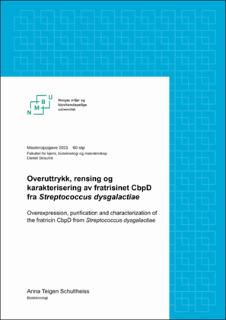| dc.contributor.advisor | Straume, Daniel | |
| dc.contributor.advisor | Kjos, Morten | |
| dc.contributor.author | Schultheiss, Anna Teigen | |
| dc.date.accessioned | 2021-10-26T08:14:37Z | |
| dc.date.available | 2021-10-26T08:14:37Z | |
| dc.date.issued | 2021 | |
| dc.identifier.uri | https://hdl.handle.net/11250/2825557 | |
| dc.description.abstract | Streptococcus pneumoniae er en viktig humanpatogen. Mye forskning er derfor blitt utført på denne og nært beslektede streptokokker, men man har ikke like mye kunnskap om de mer perifere slektningene av denne bakterien, slik som Streptococcus dysgalactiae. S. dysgalactiae koloniserer både mennesker og dyr, og den er en av de viktigste patogene bakteriene innen storfe-drift, hvor den hovedsakelig forårsaker mastitt. Mange streptokokker kan bli naturlig kompetente for genetisk transformasjon, noe som innebærer at de kan ta opp DNA fra miljøet rundt cellen og inkorporere dette i sitt eget genom. Dette er en sterk pådriver for spredning av virulens - og antibiotikaresistensgener hos streptokokker. Kompetente streptokokker uttrykker et ekstracellulært enzym, et såkalt fratrisin, som kutter i celleveggen og lyserer nært beslektede arter (fratrisid – broderdrap). Hovedhypotesen er at dette gir den kompetente cellen tilgang på homologt DNA som kan tas opp i den kompetente bakterien. S. dysgalactiae har genene som er nødvendig for å gå inn i en kompetent tilstand, men om S. dysgalactiae i det hele tatt kan, eller i hvor stor grad denne bakterien benytter seg av muligheten til å bli kompetent, er ukjent. Det at S. dysgalactiae relativt nylig har blitt assosiert med en rekke infeksjoner hos både dyr og mennesker, gjør at bakterien blir eksponert for antibiotika ved infeksjonsbehandling. Et spørsmål man ønsker svar på er derfor om S. dysgalactiae kan ta opp og spre resistensgener på lik linje som sin slektning, S. pneumoniae. Første skritt på veien er å undersøke evnen S. dysgalactiae har til å bli kompetent og om den benytter seg av fratrisidmekanismen. | en_US |
| dc.description.abstract | Streptococcus pneumoniae is an important human pathogen. A lot of research has therefore been done on this bacteria and closely related streptococci. There is not as much knowledge about the more peripheral relatives of this bacteria, such as Streptococcus dysgalactiae. S. dysgalactia colonize both human and animals and is one of the most important pathogens at cattle farms, where it mainly causes mastitis. Many streptococci can become natural competent for genetic transformation, which involves taking up DNA from the environment around the cell to incorporate it into its own genome. This strongly drives the spread of virulence - and antibiotic resistance genes for streptococci. Competent streptococci express an extracellular enzyme, a so-called fratrisin, that cuts in the cell wall and lysates closely related species (fratricide – killing its brother). The main hypothesis is that this gives the competent cell access to homologous DNA that can be taken up into the competent bacteria. S. dysgalactiae possess the genes necessary to enter a competent state, but it is unknown if S. dysgalactiae can, or in which degree, it can become competent. S. dysgalactiae has relatively recently become associated with a number of infections, both for animals and human, which is making the bacteria exposed to antibiotics in treatment of infections. A question one wish to get answered is therefore if S. dysgalactiae can take up and spread resistance genes in the same degree as its relative, S. pneumoniae. The first step is to explore the ability S. dysgalactiae has to become competent and if it uses the fratricide mechanism. | en_US |
| dc.language.iso | nob | en_US |
| dc.publisher | Norwegian University of Life Sciences, Ås | en_US |
| dc.rights | Attribution-NonCommercial-NoDerivatives 4.0 Internasjonal | * |
| dc.rights.uri | http://creativecommons.org/licenses/by-nc-nd/4.0/deed.no | * |
| dc.title | Overuttrykk, rensing og karakterisering av fratrisinet CbpD fra Streptococcus dysgalactiae | en_US |
| dc.title.alternative | Overexpression, purification and characterization of the fratricin CbpD from Streptococcus dysgalactiae | en_US |
| dc.type | Master thesis | en_US |
| dc.description.localcode | M-BIOTEK | en_US |

